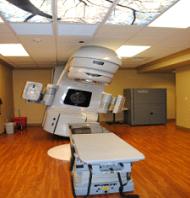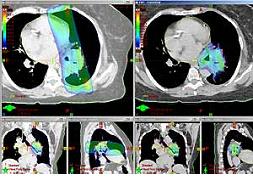External Beam
Home > Clinical Concepts In Radiation Oncology > Treatment Options > External Beam
Can we please get your advice on this one question?
External beam radiation therapy uses a high-energy x-ray machine called a linear accelerator (linac) and Telecoblat machines is to direct radiation to the tumour. The procedure lasts a few minutes, and is typically repeated several times a week over several months. The external beam radiation therapy are shown below in the figure (a)


Types of external beam radiation treatments include:
Three-dimensional conformal radiation therapy (3DCRT) is a technique where the tumour is mapped with imaging equipment and then treated with multiple beams of radiation.
Proton beam radiation therapy, similar to 3D conformal radiation therapy, this technique uses protons, instead of x-rays, to kill the tumour. Protons are parts of atoms that can pass through healthy tissues with little damage, and destroy tumour cells at the end of their path. As a result, proton beam therapy may be able to deliver more radiation to the tumour while not affecting healthy tissue near the cancer.
Intensity-modulated radiation therapy (IMRT) is a treatment method in which the intensity of the radiation can be changed during treatment. In conventional therapy, intensity is set for the entire treatment session.

Figure : planning simulation used by a radiation oncologist. Left images show larger dose via 3D conformal radiation therapy; right images show smaller dose with IMRT.
Benefits and risks of external beam therapy:
- External radiation therapy is an outpatient procedure.
- It’s a fast, painless outpatient procedure. A typical radiation treatment lasts a few minutes. It is administered over a period of six to eight weeks, typically five days a week.
- It does not carry the standard risks or complications of surgery, such as surgical bleeding, post-operative pain, or the risk of stroke, heart attack or blood clot.
- Unlike chemotherapy, which circulates through the body, ERBT is targeted to the area being treated.
Risks:
- External radiation treatment may require an investment of time — a course can involve daily sessions over several weeks.
- Common side effects of external beam radiation therapy include irritation of the treated region and fatigue.
Questions:
1. Pick out the external beam radiation therapy technique,
a) 3DCRT
b) IMRT
c) IGRT
d) ALL
Answer:
1. d) All
References:
1. http://www.upmccancercenters.com
2. http://www.cancercenter.com
3.http://www.radiationoncologyatthornton.com/wp-content/uploads/DSC_1378small.jpg
4.http://t3.gstatic.com/images?q=tbn:ANd9GcRZ35vE8MK0xPYBdzCjJ2Hj0LNkHUBCQNnP2LkGRPi2MB4X6Gd2&t=1
Home > Clinical Concepts In Radiation Oncology > Treatment Options > External Beam
FREE Infographic What successful people believe. What successful people do
Dictionary of Cancer Terms
Need help understanding a word? Here is an electronic resource that gives meaning to Cancer terms and their usage.

StrengthsFinder 2.0